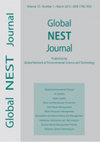膜接触器流量及组件配置对SO2吸收的影响
IF 1.2
4区 环境科学与生态学
Q4 ENVIRONMENTAL SCIENCES
引用次数: 26
摘要
二氧化硫(SO2)排放会对环境产生负面影响,它被认为是空气中较大的气态硫氧化物(SOx)的一个指标。本文以二甲胺(DMA)溶液为吸收剂,在气体速度、液体速度和290K操作温度的几个条件下操作了α-Al2O3中空纤维膜接触器。研究了中空纤维膜接触器中气相、液相性质和模块结构对SO2吸收效率的影响。模拟结果表明,气相速度、液相速度和浓度的变化对SO2的吸收效率有很大影响。气体流速的增加降低了SO2的吸收效率,而液体流速的增加具有相反的效果,提高了效率。因为气体在膜组件中停留的时间更长,所以更多的吸收时间促进了气体和液体的反应。然而,混合气体中SO2体积分数的变化对SO2的吸收并不显著。该模拟模型可以为中空纤维膜接触器吸收SO2过程中选择合适的流体特性提供指导。本文章由计算机程序翻译,如有差异,请以英文原文为准。
Effect of flow and module configuration on SO2 absorption by using membrane contactors
Sulfur dioxide (SO2) emissions lead to negative environmental impacts and it is considered as an indicator for the larger group of gaseous sulfur oxides (SOx) in the air. In this paper, the dimethylamine (DMA) solution was used as the absorbent in a α-Al2O3 hollow fiber membrane contactor that is operated under several conditions of gas velocity, liquid velocity, and 290 K operating temperature. The effects of gas and liquid phase properties and module configuration on SO2 absorption efficiency in the hollow fiber membrane contactor were investigated. Simulation results showed that the changes of gas phase velocity, liquid phase velocity, and concentration have great influences on the absorption efficiency of SO2. An increase of the gas flow rate decreases the SO2 absorption efficiency, while an increase of the liquid flow rate has the opposite effect, increasing the efficiency. Because gas in the membrane module stays for a longer time, more absorption time promotes the gas and liquid reaction. However, the changes of the volume fraction of SO2 in the mixed gas are not significant to SO2 absorption. The simulation model could provide guidelines for selecting suitable fluid properties during the SO2 absorption process in a hollow fiber membrane contactor.
求助全文
通过发布文献求助,成功后即可免费获取论文全文。
去求助
来源期刊

Global Nest Journal
环境科学-环境科学
CiteScore
1.50
自引率
9.10%
发文量
100
审稿时长
>12 weeks
期刊介绍:
Global Network of Environmental Science and Technology Journal (Global NEST Journal) is a scientific source of information for professionals in a wide range of environmental disciplines. The Journal is published both in print and online.
Global NEST Journal constitutes an international effort of scientists, technologists, engineers and other interested groups involved in all scientific and technological aspects of the environment, as well, as in application techniques aiming at the development of sustainable solutions. Its main target is to support and assist the dissemination of information regarding the most contemporary methods for improving quality of life through the development and application of technologies and policies friendly to the environment
 求助内容:
求助内容: 应助结果提醒方式:
应助结果提醒方式:


